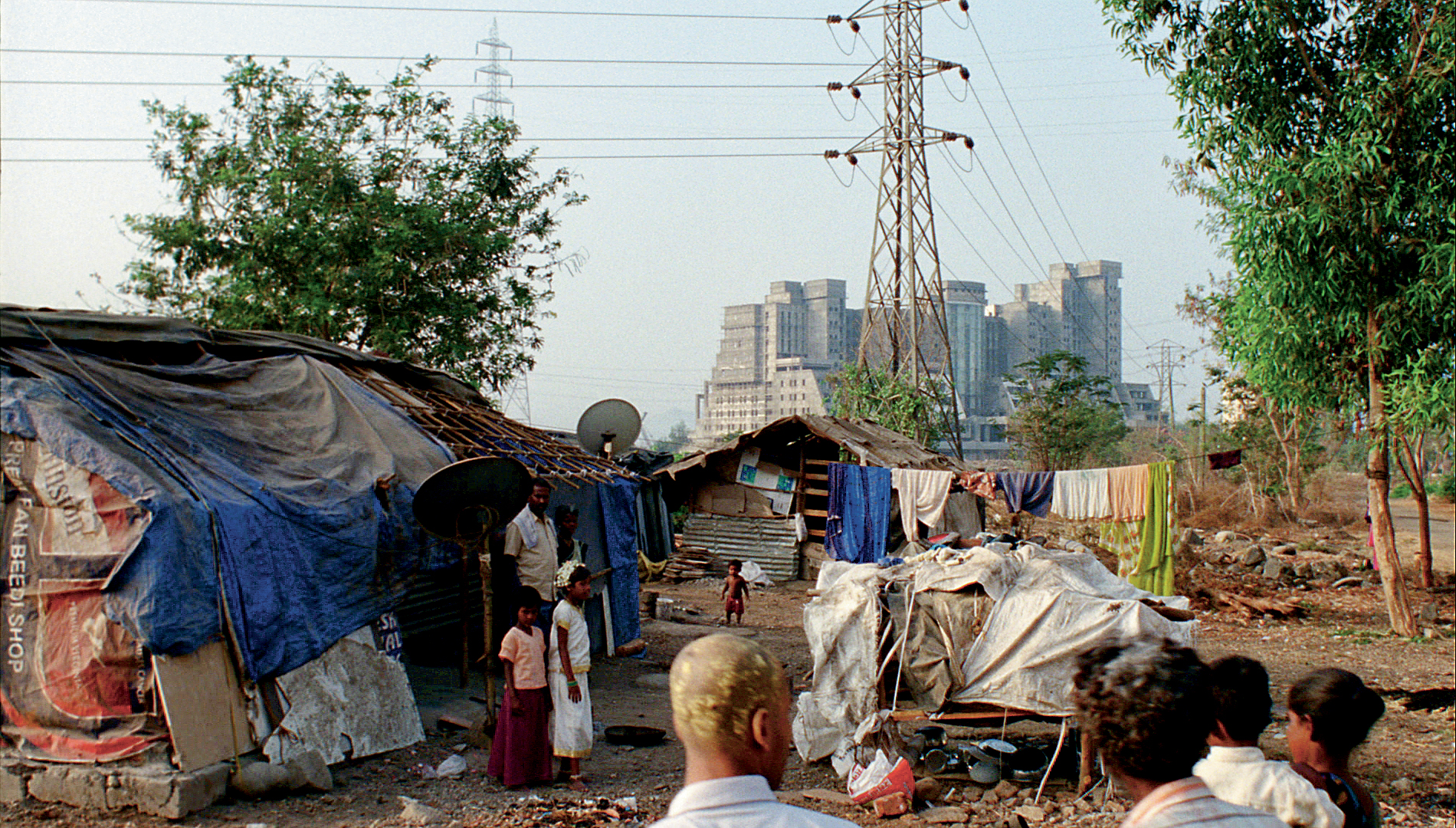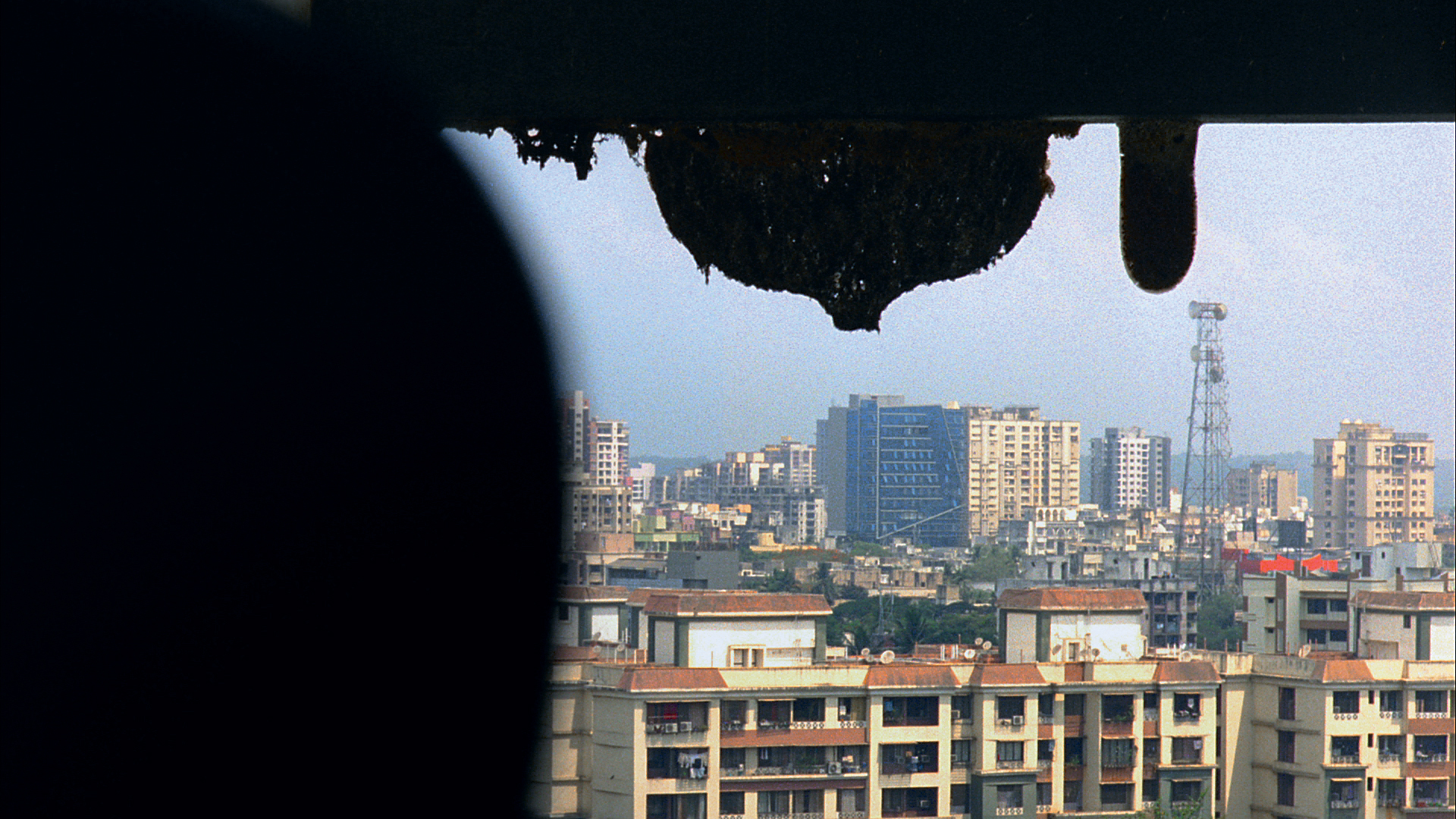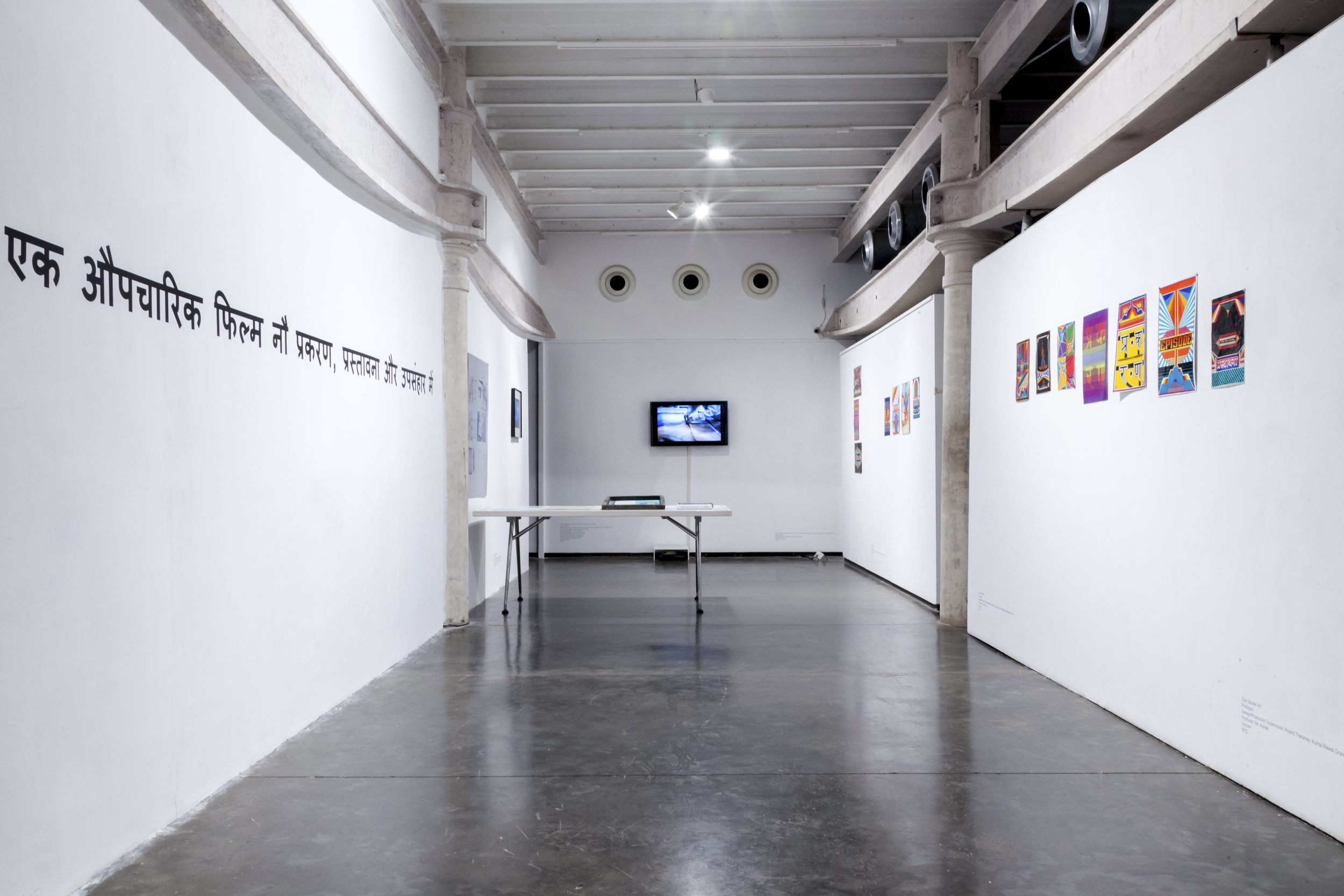Installation View: Frankfurter Kunstverein, 2010
A FORMAL FILM IN NINE EPISODES, PROLOGUE & EPILOGUE
35mm Film / HD - Video - Multiple - Projection for Exhibition Space, Stereo, 52min
Hindi, Tamil with English Subtitles
© 2010 India/ Germany
Courtesy of KOW Berlin & Mario Pfeifer & [blackboardfilms]
A FORMAL FILM IN NINE EPISODES, PROLOGUE & EPILOGUE describes a contemporary Asian Metropolis through an observational, anthropological approach to filmmaking. The scenery depicted in the nine episodes portrays landscape, architecture, interiors or humans from rural communities to factories, medical facilities or ancient and religious sites. The sites all share miraculous beauty, yet the film explores a critical, self-reflexive and aesthetic exploration of the cities development as well as its cultural phenomena. Slowly establishing two characters, the film leaves its’ documentarian nature and progresses into a narrative, which follows two humans, sharing their movements in time and space letting us remember a cinema of love in the Asian context.
Shot on 35mm in only single takes, the production of the film attempts to be aware of its outsider position looking at a contemporary, vastly booming Third World Country and it’s cultural history of 5,000 years by capturing and re-enacting experienced situations. Trying to avoid a clear genre definition to this film, it is entirely shot on location in the city of Mumbai and it’s suburbia. Both performers, Gopal and Nandani, work regular day jobs and live in Bombay’s suburbia - and have never participated in a film project ever in their lives before.
Director of Photography: Avijit Mukul Kishore
Sound Design: Thomas Wallmann
Assistant Director / Research Assistant: Sujata Venkateswaran
Sound Operator: Suresh Rajamani
Casting: Mario Pfeifer / Sujata Venkateswaran / Parul Wadhwa
Production /Location Manager: Dhiraj Singh
Production Assistant: Parul Wadhwa
Translation: Ragunath Vasudevan
Colorist: Emilio Batungbacal
Supported by Kodak Mumbai, Frankfurter Kunstverein & Museum für Moderne Kunst, Frankfurt am Main
Awarded by werkleitz - centre for media art - for a post-production grant
Produced by [blackboardfilms]
Conceived by Mario Pfeifer
Video Stills, 2010
Project 88, Mumbai
Solo Exhibition
April 27 - May 28 ,2013
Opening Reception April 27th, 6-9pm
Project 88 and Goethe-Institut Max Mueller Bhavan are proud to announce Mario Pfeifer's first solo exhibition in India presenting his acclaimed and widely exhibited installation project A Formal Film in Nine Episodes, Prologue & Epilogue (2010) for the first time in the city of its making.
During his research and the production period in 2010, Pfeifer developed a multi-layered, visually compelling and critically challenging film project, shot on 35 mm colour negative in single takes with two Greater Bombay citizens unfamiliar with the process of producing a conceptual film but highly knowledgable about their own area, its local culture and diversity of languages.
In close collaboration with his research assistants, Pfeifer went on extensive location visits observing everyday situations and activities that he first considered on a formal level, approaching them, as he puts it, in a state of innocence – entering a complex environment without preconceptions. By further investigating the social, urban, ethnographic, religious and cultural contexts inherent in his formal approach, he developed the structural concept of the film, which was later worked into the project's title. Presented as what Amira Gad defines as a “flexible installation”, [1] Pfeifer suggests a loose ordering of his episodes, prologue and epilogue within the setting of an exhibition space, varying the number of projections and declining to specify the order and number of episodes to be screened together. This flexibility creates the possibility for the projected material to be displayed in diverse narrative combinations and asks spectators to engage with the exhibition space and the filmic representation by applying their own individual gaze and critique, a personal process of translating the experience.
Pfeifer's images, framed by cinematographer Avijit Mukhul Kishore, are rich in colour and sounds, kaleidoscopic depictions of architectures, a factory, a clinic, urban development, religious and ethnographic sites – an investigation of the city's growth from rural areas to high-tech sites and planned cities, from manual labour to neoliberal, global forms of production.
With its images resistant to any clearly defined genre, the film meanders between what are considered documentary and fictive notions of image production, pointing at the difficulties inherent in the act of representation per se and the artist's own involvement in a local context he would otherwise not be part of. Shanay Jhaveri asks in his essay on Pfeifer's undertaking: “Do the images cave in under layered formal choices that seek to clearly forefront an awareness of the ethics of representation or do they absorb the formal choices?” [2] Ranjit Hoskote notes that “Pfeifer's approach provokes me into asking whose reality it is that is being represented ... Even as recently as ten years ago, it seemed politically appropriate for Indians like myself – scholars, critics, theorists, artists and curators – to deploy a 'strategic essentialism' [3] ... and claim an authority by birthright over any representation of India or Indians ... On the contrary [this film] provokes me into a state of curiosity, acting by allusive indirection.” [4]
With A Formal Film Mario Pfeifer distances himself from documentarism and the use of commentaries, and instead casts doubts on the social critique that such aesthetics evoke, which itself might appear as a form of colonialist encroachment in today's globalized society.
In conjunction with previous exhibitions at MMK Museum für Moderne Kunst Frankfurt am Main and KOW, Project 88, KHOJ Artist Association and Goethe-Institut Max Mueller Bhavan present Pfeifer's recent publication A Formal Film in Nine Episodes, Prologue and Epilogue – A Critical Reader (2013), published in Hindi and English and distributed internationally by Spector Books. With numerous contributions from Berlin, Frankfurt, London, Mumbai, New Delhi and Rotterdam, the reader discusses in depth the societal, cultural and aesthetic issues suggested in Pfeifer's practice. As the publication was conceived after a research trip made by designer Markus Weisbeck with the artist in 2012, the production took place in collaboration with Mumbai-based printers and manufacturers with design contributions by Kurnal Rawat/Grandmother India. It was supervised by Eve Lemesle, Anand Tharaney and Ragunath V, whose video on the publication's making will be presented during the exhibition.
1 Amira Gad: “Blurring the Boundaries” in A Formal Film in Nine Episodes, Prologue and Epilogue – A Critical Reader (Spector Books, Leipzig, 2013), p.138
2 Shanay Jhaveri:“'Inside' and 'Outside' a Frame of Historical and Cultural Referentiality?”, ibid., p.58
3 See Sara Danius, Stefan Jonsson and Gayatri C. Spivak, “An Interview with Gayatri Chakravorty Spivak”, in Boundary 2, Vol. 20 No. 2 (Duke University Press, Summer 1993), pp. 24–50.
4 Ranjit Hoskote: “Imagining India” in A Formal Film, pp. 242–246
Exhibition views by A. Fernandez.
All images are courtesy of Mario Pfeifer & KOW.
Installation View: KOW, Berlin, 2011
KOW Berlin
Solo Exhibition
September 10 - October 28, 2011
When he came to Mumbai, India, in 2010, Mario Pfeifer faced a problem that had
already vexed Pier Paolo Pasolini and Louis Malle, who traveled to India in 1968, and
many cinematic auteurs after them: What to show of a country and a culture that still
strike the Western filmmaker as mostly unfamiliar and exotic? How would they avoid
a colonialist perspective replete with standards of value they have brought with them?
How might they catch a glimpse of what lies beyond the stereotypes about social
inequality, about the misery of lower-caste life and the upwardly mobile middle
classes, that dominate the critical picture of India in the minds of Westerners? Louis
Malle thought it was impossible. In his classic „L’Inde Fantôme“, he spends 378
minutes commenting on the limitations of his own view.
It is this problem that Mario Pfeifer’s 35 mm production „A Formal Film in Nine
Episodes, Prologue & Epilogue“ addresses. We show the work as a multipart installation
on three floors. Pfeifer uses lay actors to stage various perspectives on everyday
life in Mumbai. Held together by a loose narrative, the open sequence of episodes
arranges local sceneries as though in a kaleidoscope: a cab ride, fishermen on a
river, a visit to a temple, workers in an ice factory. Pfeifer seeks out places that
offer themselves as symptomatic sites to a social critique, talks to the citizens,
researches backgrounds. He reenacts situations based on real situations and then
shoots them a single time. Yet his gaze through the camera finally gives a surprising
phenomenological twist to such methods of documentarism and realism: its attachment
is solely to what is visible. Instead of looking for a filmic representation that
seeks to do justice to the social world he finds, he gleans atmospheric details. And
instead of offering a penetrating critique of what he sees, he focuses entirely on
formal aspects: on colors and the qualities of materials, on stretches of time and
sequences of motion, on sounds.
Pfeifer knows that there is no escaping the Western conditioning that informs his
eye—but that does not stop him from seeing. So he formalizes what is happening
and captures the inherent dynamism of the cinematographic apparatus in filmic
tableaux he distributes across an exhibition architecture built for this purpose. Its
rigorous and mannerist formal calculation suggests a kinship between his images
and the paintings Gustave Caillebotte created around 1875, works that Jeff Wall
also drew on. And not unlike Wall, Pfeifer not only does not align what can be seen
of social landscapes, what can be shown of them, and what can be known about
them—he does not even offer his audiences a coherent perspective of interpretation.
Looking at what are allegedly social hot spots of a “developing country,” „A Formal
Film“ arrives at motifs of a disturbing beauty that defy easy consumption, either as
exotica or as critical clichés. Mumbai remains, for the time being, the phenomenon
that it already was for Louis Malle. Yet unlike Malle, Pfeifer distances himself from
documentarism, casting even the posture of commentary and critical information in
doubt: documentary social critique itself appears as a form of colonialist encroachment.
[Text by Alexander Koch]
Exhibitions
Galerie für Zeitgenössische Kunst | Museum of Contemporary Art, Leipzig, Germany, 2016
Khoj, New Delhi, 2013
Project 88, Mumbai, 2013
MMK Museum für Moderne Kunst, Frankfurt am Main, 2012
The Cultural Centre of Brugge, 2012
Nassauischer Kunstverein, Wiesbaden, 2011
KOW Berlin , 2011
Frankfurter Kunstverein &
Zollamt MMK Museum für Moderne Kunst Frankfurt, 2010
Screenings
MoMA PS1, 2013
World Film Festival, Bangkok, 2012
Migrating Forms, New York, 2011 [North America Premiere]
London International Documentary Film Festival, 2011 [World Premiere]
Related Lectures
MoMA PS1, New York, 2013
Artists Space, New York, 2013
Studio X, Mumbai, 2013
Khoj, New Delhi, 2013
Bauhaus Universität, Weimar, 2013
Academy of Visual Arts, Leipzig, 2013
MMK Museum für Moderne Kunst Frankfurt am Main, 2013
Selected Press
ArtSlant, May 2013
Episodic Encounters: “We read, we travel, we become”
Deepika Sorabjee on Mario Pfeifer, Review project88, Solo Exhibition
Indian Express Mumbai, May 2013
"Multilayered City"
Sankhayan Gosh on Mario Pfeifer, Review project88, Solo Exhibition
Artforum, December 2011
John Beeson on Mario Pfeifer, Review KOW Berlin Solo Show
Art Review, December 2011
Kimberly Bradley on Mario Pfeifer, Review KOW Berlin Solo Show
Frankfurter Allgemeine Zeitung, 27/11/2011
"Image, Reality and Staging" by Christoph Schütte
The Brooklyn Rail, July 2011
"BLURRED BOUNDARIES: Selections from Migrating Forms 2011"
by Colin Beckett and Jason Livingston
Slant Magazine - Art Politics Commentary, May 2011
Mysteries of Space and Time: Migrating Forms '11 by Ricky D'Ambrose
Installation View: Zollamt MMK Museum für Moderne Kunst Frankfurt am Main, 2010
Installation View: MMK Museum für Moderne Kunst Frankfurt am Main, 2012
Installation View: MMK Museum für Moderne Kunst Frankfurt am Main, 2012
Installation View: MMK Museum für Moderne Kunst Frankfurt am Main, 2013
KHOJ, New Delhi
Solo Exhibition
May 3 - 24, 2013
Opening Reception May 3rd, 6-8pm
w/ a book launch of A Formal Film in Nine Episodes, Prologue and Epilogue – A Critical Reader (2013) at 8 pm, followed by a conversation between Mario Pfeifer and Kaushik Bhaumik.
Khoj International Artists' Association and Goethe-Institut/Max Mueller Bhavan announce Mario Pfeifer's first solo exhibition at an Indian institution presenting his acclaimed and widely exhibited installation project A Formal Film in Nine Episodes, Prologue & Epilogue (2010).
The multiple-channel high-definition video installation, originally shot on 35 mm colour negative, was preceded by extensive on-location research in Greater Mumbai . Meticulously framed moving images – shot by Avijit Mukul Kishore – and a detailed soundscape present a kaleidoscopic view of a megalopolis that is constantly growing and altering. Taking a formal approach to the situations he encountered, Mario Pfeifer reveals societal issues of class, urban change, notions of manual and digital production and attitudes towards religious, cultural and symbolic customs. In the process he declines to provide any explanation or commentary to accompany the scenes he depicts. Instead his project offers an open space for spectators to actively and critically engage with the visible on an individual basis, acknowledging there may be diverse possible readings for audiences. While the audience have different points of access in the installation, cultural backgrounds and experiences, together constitute today's global society, shaped as it is by common sources of knowledge production and development.
Composed of mutually independent, self-contained episodes, the installation is of a flexible nature as the combination of episodes, prologue and epilogue, as well as the number of projections, alters in correspondence to curatorial ideas and the architectural condition of the exhibition space it is shown in. With its images resistant to classification within any clearly defined genre, the film meanders between what is considered documentary and fictive notions of image production, pointing at the difficulties inherent in the act of representation and the artist's own involvement in a local context he would otherwise not be part of. With A Formal Film Mario Pfeifer distances himself from documentarism and the use of commentaries, and instead casts doubts on the social critique that such aesthetics evoke and which itself might appear as a form of colonialist encroachment in today's globalized society.
Following his installation project and its wide reception in the West, Pfeifer devoted the last year to editing A Critical Reader, including it as part of his project and a means to collaboratively investigate many of the themes and issues that are raised in his film and resonate within society today. In a series of conversations and essays scholars from diverse fields and of different national and cultural origins were invited to reflect on cultural production, national identity, education, class relations, urban, economic and social themes. Kaushik Bhaumik remarks in his essay Surfacing the Alchemical Urban that “many strategies of the film come together in the figure of the eunuch – an attempt to mix concrete and flesh and the idea of conjugality”, and further wonders if “India's asymmetrical modernity [is] made possible and indeed blessed by the 'androgynous' presence of the 'lower middle class' in vast numbers?” In his essay on Pfeifer's undertaking, Shanay Jhaveri asks: “Do the images cave in under layered formal choices that seek to clearly forefront an awareness of the ethics of representation or do they absorb the formal choices?”. Ranjit Hoskote notes that “Pfeifer's approach provokes me into asking whose reality it is that is being represented ... Even as recently as ten years ago, it seemed politically appropriate for Indians like myself – scholars, critics, theorists, artists and curators – to deploy a 'strategic essentialism' ... and claim an authority by birthright over any representation of India or Indians ... On the contrary [the film] provokes me into a state of curiosity, acting by allusive indirection.”
In conjunction with previous exhibitions at MMK Museum für Moderne Kunst Frankfurt am Main and KOW, Project 88, Khoj Artist Association and Goethe-Institut/Max Mueller Bhavan present Pfeifer's recent publication A Formal Film in Nine Episodes, Prologue and Epilogue – A Critical Reader (2013), designed by Markus Weisbeck/Surface and published in Hindi and English and distributed internationally by Spector Books. With numerous contributions from Berlin, Frankfurt, London, Mumbai, New Delhi and Rotterdam, the book production took place in collaboration with Mumbai-based printers and manufacturers with design contributions by Kurnal Rawat/Grandmother India. It was supervised by Eve Lemesle, Anand Tharaney and Ragunath V.
The exhibition is organized by Khoj International Artist Association and Goethe-Institut/Max Mueller Bhavan and runs from 3 May until 24 May 2013. Please join us for the opening reception with artist Mario Pfeifer on 3 May at 6 pm.
During the opening night Markus Weisbeck (designer and professor for Visual Communication at Bauhaus Universität Weimar) and Ragnuath V (architect, photographer and filmmaker) will present the publication's conception and production while Mario Pfeifer and Kaushik Bhaumik will engage in a dialogue on the different notions of film, critical reader, their receptions and possible readings, starting at 8 pm.
1 Kaushik Baumhik: “Surfacing the Alchemical Urban” in A Formal Film in Nine Episodes, Prologue and Epilogue – A Critical Reader (Spector Books, Leipzig, 2013), p.174
2 Shanay Jhaveri:“'Inside' and 'Outside' a Frame of Historical and Cultural Referentiality?”, ibid., p.58
3 See Sara Danius, Stefan Jonsson and Gayatri C. Spivak, “An Interview with Gayatri Chakravorty Spivak”, in Boundary 2,Vol. 20 No. 2 (Duke University
Press, Summer 1993), pp. 24–50.
4 Ranjit Hoskote: “Imagining India” in A Formal Film, pp. 242–46
Installation View: Galerie für Zeitgenössische Kunst | Museum of Contemporary Art, Leipzig, Germany, 2016























